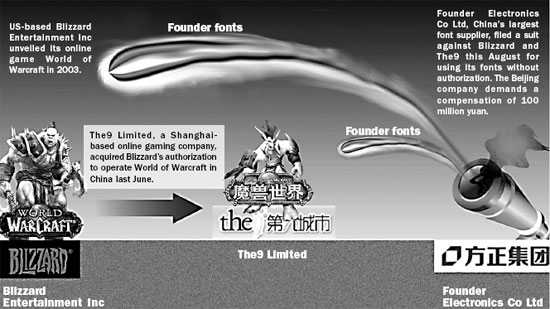Type Face-off

Chinese companies, after years of being branded copycats and counterfeiters, have begun to defend their own intellectual property (IP) at home and abroad as a result of their rising awareness and surging investment in innovation.
A recent example is Beijing Founder Electronics Co Ltd, the nation's largest font supplier, which sued online game companies Blizzard Entertainment and The9 on August 14 over unauthorized use of its type fonts.
Founder Electronics alleges the two companies, which operate the online game World of Warcraft in China, have used without authorization five fonts for which it owns the copyrights.
The Beijing-based company said the infringement has resulted in over 1 billion yuan in losses and requires compensation of 100 million yuan.
According to Founder Electronics, it is the largest IPR case filed by a Chinese company against a foreign enterprise since China joined the World Trade Organization (WTO).
"Companies should acquire our authorization before putting our fonts into commercial use," says Song Zhenying, a spokesperson for Founder Group, the parent company of Founder Electronics. "Neither Blizzard and The9 have done that before using them in the game."
Zhao Yurun, public relations director of The9, declined to comment on the issue in a telephone interview with China Business Weekly, saying the company was still preparing for the lawsuit.
Song said Founder Electronics filed the case with the High People's Court of Beijing Municipality on June 18 and expects the court to make a ruling soon.
"The case is the latest sign that IP awareness of Chinese companies has grown rapidly from hardly knowing what it is to guarding it with legal tools," said Chen Jihong, partner of Beijing-based Zhonglun W&D Law Firm.
China adopted laws for intellectual property as early as the 1980s, but local companies only became familiar with the concept with the nation's membership in the WTO in 2001, when the government made a series of commitments to strengthen intellectual property protection.
Overseas companies have since embarked campaigns to protect their intellectual property in China as the government moved to crack down on counterfeiting and piracy. Since China joined the WTO, domestic companies have paid more than $1 billion in compensation for IP violations, according to International Business Daily.
"At first Chinese companies were often caught as the defendants in IP cases, and some were even punished for infringements," says Chen. "But over the years, they quickly learned to stay away from the mine field, but also start to build their own fences."
Founder Electronics began to develop Chinese fonts in 1974, when its founder Wang Xuan, a professor from Beijing University, developed China's first electronic typesetting system. The company says it has more than 90 percent of the font market in China's publishing industry and supplies 70 percent to 80 percent of the fonts used in the nation's TV industry.
The suit against the online game operators is not the company's first court case to protect its fonts. In 2005, it filed a similar case against a Shandong-based software company and received 300,000 yuan in compensation.
Increasing spending by domestic companies on research and development (R&D) also contributes to the rising awareness about intellectual property, says Chen.
China, which was long seen as an assembly base for overseas companies, has been promoting its homegrown enterprises to invest in innovation and move up the value chain. In 2006, the nation overtook Japan as the world's second-largest spender on R&D behind the US, according a report by the Organization for Economic Cooperation and Development (OECD).
The country invested an estimated $136 billion in R&D in 2006, more than the $130 billion by Japan, but still well behind the $330 billion spent in the US, the OECD report says. The organization also says the China's spending on R&D as a percentage of gross domestic product grew from 0.6 in 1995 to 1.3 percent in 2006.
The investment in innovation has already paid off as illustrated by the nation's soaring patent numbers. Patent filings increased by over eight-fold in between 1995 and 2005 as the country rose to be the fifth-largest in patents filed during the period, according to a report by the World Intellectual Property Organization, a UN agency.
In 2005, the latest year of which complete statistics are available, China's patent office saw the highest growth rate in the world, at 42.1 percent, while global numbers of rose by 4.7 percent.
The amount spent on R&D means a great deal of innovation, and homegrown companies like Founder Electronics are now developing their skills for guarding their own interests at home and abroad.
In July, General Protecht, an electrical goods manufacturer in East China's Zhejiang Province, won a three-year-long patent infringement lawsuit in the US.
In April 2004, US-based Leviton filed lawsuits against several customers of General Protecht in New Mexico, Florida and California, alleging patent infringements on its ground fault circuit interrupter, a small electrical device used to reduce the risk of electrocution.
General Protecht, whose products are widely exported, then employed to a US law firm to prepare for the suit. The company said it paid great attention to patents over the years and had obtained several invention patents and outward design patents in China as well as in the US.
After three years of legal proceedings, a federal Court in New Mexico ruled the device made by General Protecht did not infringe on the patents of Leviton.
During the legal process, General Protecht had declining sales in the US while paying hefty legal fees.
"But we vowed not to back down, as we believe Chinese companies can be treated fairly and impartially according to the rule of law in the US", said Chen Wusheng, General Protecht's president in an earlier interview with China Daily.
(China Daily 09/03/2007 page9)
 Print
Print